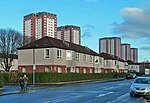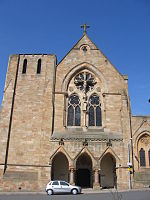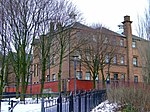Sighthill, Glasgow
Sighthill is a neighbourhood in the Scottish city of Glasgow. It is situated north of the River Clyde and is part of the wider Springburn district in the north of the city. It is bordered to the north by Cowlairs, to the east by the Springburn Bypass road and the Royston neighbourhood, to the west by the Glasgow to Edinburgh via Falkirk Line (running into Queen Street Station) and to the south by the Townhead interchange of the M8 Motorway. The district is primarily residential and from the mid-1960s consisted of a housing estate split into two sub-areas – Pinkston to the south and Fountainwell to the north – each with five 20-storey 'slab' tower blocks, plus seven 5-storey maisonette blocks and five rows of tenements in between. Most of these buildings were demolished during the early 21st century and replaced by new housing with associated infrastructure and landscaping.
Excerpt from the Wikipedia article Sighthill, Glasgow (License: CC BY-SA 3.0, Authors).Sighthill, Glasgow
Glasgow Sighthill
Geographical coordinates (GPS) Address Nearby Places Show on map
Geographical coordinates (GPS)
| Latitude | Longitude |
|---|---|
| N 55.8713 ° | E -4.2374 ° |
Address
G4 0DD Glasgow, Sighthill
Scotland, United Kingdom
Open on Google Maps









